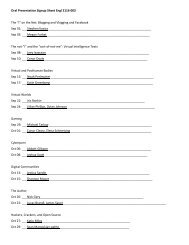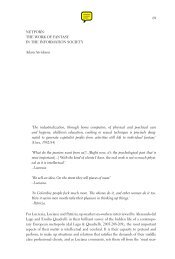Nakamura, Digitizing Race, Introduction, chapter 5, Epilogue
Nakamura, Digitizing Race, Introduction, chapter 5, Epilogue
Nakamura, Digitizing Race, Introduction, chapter 5, Epilogue
You also want an ePaper? Increase the reach of your titles
YUMPU automatically turns print PDFs into web optimized ePapers that Google loves.
192 Measuring <strong>Race</strong> on the Internet<br />
for U.S. visitors who travel via plane, and the recent call for biometric<br />
identification papers for air travel by the International Civil Aviation Organization.<br />
As noted in <strong>chapter</strong> 3, this open letter to the ICAO singles out facial<br />
recognition technology as problematic because it may be used to “reveal<br />
racial or ethnic origin.” The “Gay or Asian” image deploys the visual culture<br />
of racialization to create its own brand of facial-recognition technology, one<br />
that positions its subject not only in relation to border and immigration status<br />
but also in relation to class and sexuality. Alexander Galloway writes<br />
that new networked biometric technologies—“The science of measuring the<br />
human body and deriving digital signatures from it”—are worrisome not<br />
only because of their possible infringements on privacy, but also because<br />
they have “redefined what counts as proof of the true identity of material life<br />
forms. Authenticity (identity) is once again inside the body-object, yet it<br />
appears now in sequences, samples, and scans.” 52 The “true identity” of the<br />
queer or raced male subject, its outing via the visual culture of biometrics,<br />
may not overtly participate in the “digital signature” described by Galloway,<br />
but the reaction to the image that appeared on petitiononline.com literally<br />
produced digital signatures by material bodies, actual people who logged on<br />
and wrote comments. These bodies, however, lack the authenticity or presence<br />
guaranteed by biometrics and thus evade the dataveillant gaze; it is<br />
impossible to tell what race or gender or sexuality they are, a point to which<br />
I will return.<br />
When we analyze the online response to “Gay or Asian?” we can trace<br />
the ways in which the protesting of racial and gender stereotypes, new media,<br />
technology, and Asian Americans constellate. The signatures that petitioners<br />
leave are anarchic, unorganized, and astoundingly diverse. Like the discussion<br />
boards on alllooksame.com, these often very short and truncated<br />
postings create a processual, problematized vision of Asian American identity<br />
on precisely the kind of electronic medium that one might expect would<br />
preclude it. On March 30 there were 14,589 signatures on Daniel Lee’s<br />
“Asians against Ignorance” petition at petitiononline.com pushing for a<br />
boycott of Details magazine, and on April 27 it had 32,964 signatures. 53<br />
Considering that the site’s petition is quite straightforward about protesting<br />
the racism behind the “Asian or Gay?” article, the responses are themselves<br />
interestingly all over the map. However, this is itself a statement as to the<br />
multivalent uses to which the Asian American community, at least as constituted<br />
by this board in the moment of signing the petition, wishes to put<br />
this discursive space.





